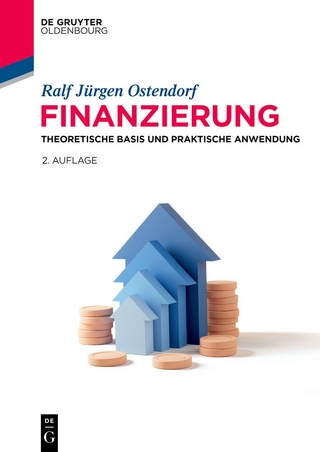
Postmodern Portfolio Theory
Palgrave Macmillan (Verlag)
978-1-349-71353-0 (ISBN)
- Titel wird leider nicht erscheinen
- Artikel merken
A comprehensive approach to financial risk management must address all aspects of portfolio theory, from the beautiful symmetries of modern portfolio theory to the disturbing behavioral insights and the vastly expanded mathematical arsenal of the postmodern critique. Mastery of postmodern portfolio theory's quantitative tools and behavioral insights holds the key to the efficient frontier of risk management.
James Ming Chen holds the Justin Smith Morrill Chair in Law at Michigan State University, USA. He teaches, lectures, and writes widely on law, economics, and regulation. His books, Disaster Law and Policy and Postmodern Portfolio Theory, cover a broad range of issues concerning extreme events and risk management, from natural to financial disasters. He is of counsel to the Technology Law Group of Washington, D.C.; a public member of the Administrative Conference of the United States; and an elected member of the American Law Institute. A magna cum laude graduate of Harvard Law School and a former editor of the Harvard Law Review, Chen also served as a clerk to Justice Clarence Thomas of the Supreme Court of the United States.
Part I - Perpetual Possibility in a World of Speculation: Portfolio Theory in Its Modern and Postmodern Incarnations Chapter 1 - Modern Portfolio Theory 1.1 - Mathematically informed risk management 1.2 - Measures of risk; the Sharpe ratio 1.3 - Beta 1.4 - The capital asset pricing model 1.5 - The Treynor ratio 1.6 - Alpha 1.7 - The efficient markets hypothesis 1.8 - The efficient frontier Chapter 2 - Postmodern Portfolio Theory 2.1 - A renovation project 2.2 - An orderly walk 2.3 - Roll's critique 2.4 - The echo of future footfalls Part II - Bifurcating Beta in Financial and Behavioral Space Chapter 3 - Seduced by Symmetry, Smarter by Half 3.1 - Splitting the atom of systematic risk 3.2 - The catastrophe of success 3.3 - Reviving beta's dead hand 3.4 - Sinking, fast and slow Chapter 4 -The Full Financial Toolkit of Partial Second Moments 4.1 - A history of downside risk measures 4.2 - Safety first 4.3 - Semivariance, semideviation, and single-sided beta 4.4 - Traditional CAPM specifications of volatility, variance, covariance, correlation, and beta 4.5 - Deriving semideviation and semivariance from upper and lower partial moments Chapter 5 - Sortino, Omega, Kappa: The Algebra of Financial Asymmetry"/p> 5.1 - Extracting downside risk measures from lower partial moments 5.2 - The Sortino ratio 5.3 - Comparing the Treynor, Sharpe, and Sortino ratios 5.4 - Pythagorean extensions of second-moment measures: Triangulating deviation about a target not equal to the mean 5.5 - Further Pythagorean extensions: Triangulating semivariance and semideviation 5.6 - Single-sided risk measures in popular financial reporting 5.7 - The trigonometry of semideviation 5.8 - Omega 5.9 - Kappa 5.10 - An overview of single-sided measures of risk based on lower partial moments 5.11 - Noninteger exponents versus ordinary polynomial representations Chapter 6 - Sinking, Fast and Slow: Relative Volatility Versus Correlation Tightening 6.1 - The two behavioral faces of single-sided beta 6.2 - Parameters indicating relative volatility and correlation tightening 6.3 - Relative volatility and the beta quotient 6.4 - The low-volatility anomaly (and Bowman's paradox) 6.5 - Correlation tightening 6.6 - Correlation tightening in emerging markets 6.7 - Isolating and pricing correlation risk 6.8 - Low volatility revisited 6.9 - Low volatility and banking's "curse of quality" 6.10 - Downside risk, upside reward Part III - TAU sigmasigmaepsilonrhoalpha, TAU sigmasigmaepsilonrhoalpha : Four Dimensions, Four Moments Chapter 7 - Time-Varying Beta: Autocorrelation and Autoregressive Time Series 7.1 - Finding in motion what was lost in time 7.2 - The conditional capital asset pricing model 7.3 - Conditional beta 7.4 - Conventional time series models 7.5 - Asymmetrical time series models Chapter 8 - Asymmetric Volatility and Volatility Spillovers 8.1 - The origins of asymmetrical volatility; the leverage effect 8.2 - Volatility feedback 8.3 - Options pricing and implied volatility 8.4 - Asymmetrical volatility and volatility spillover around the world Chapter 9 - A Four-Moment Capital Asset Pricing Model 9.1 - Harbingers of a four-moment capital asset pricing model 9.2 - Four-moment CAPM as a response to the Fama-French-Carhart four-factor model 9.3 - From asymmetric beta to coskewness and cokurtosis 9.4 - Skewness and kurtosis 9.5 - Higher-moment CAPM as a Taylor series expansion 9.6 - Interpreting odd versus even moments 9.7 - Approximating and truncating the Taylor series expansion 9.8 - Profusion and confusion over measures of coskewness and cokurtosis 9.9 - A possible cure for portfolio theory's curse of dimensionality: Relative lower partial moments Chapter 10 - The Practical Implications of a Spatially Bifurcated Four-Moment Capital Asset Pricing Model 10.1 - Four-moment CAPM versus the four-factor model 10.2 - Correlation asymmetry 10.3 - Emerging markets 10.4 - Size, value, and momentum Part IV - Managing Kurtosis: Measures of Market Risk in Global Banking Regulation < Chapter 11 - Going to Extremes: Leptokurtosis as an Epistemic Threat 11.1 - Value-at-risk (VaR) and expected shortfall in global banking regulation 11.2 - Leptokurtosis, fat tails, and non-Gaussian distributions Chapter 12 - Parametric Value-at-Risk (VaR) Analysis 12.1 - The Basel Committee on Bank Supervision and the Basel accords 12.2 - The vulnerability of VaR analysis to model risk"/p> 12.3 - Gaussian VaR 12.4 - A simple worked example Chapter 13 - Parametric VaR According to Student's t-Distribution 13.1 - Choosing among non-Gaussian distributions 13.2 - Stable Paretian distributions 13.3 - Student's t-distribution 13.4 - The probability density and cumulative distribution functions of Student's t-distribution 13.5 - Adjusting Student's t-distribution according to observed levels of kurtosis 13.6 - Performing Parametric VaR Analysis with Student's t-distribution Chapter 14 - Comparing Student's t-Distribution with the Logistic Distribution 14.1 - The logistic distribution 14.2 - Equal kurtosis, unequal variance Chapter 15 - Expected Shortfall as a Response to Model Risk 15.1 - Value-at-risk versus expected shortfall 15.2 - The incoherence of VaR 15.3 - Extrapolating expected shortfall from VaR 15.4 - A worked example 15.5 - Formally calculating expected shortfall from VaR under Student's t-distribution 15.6 - Expected shortfall under a logistic model Chapter 16 -Latent Perils: Stressed VaR, Elicitability, and Systemic Risk 16.1 - Additional concerns 16.2 - Stressed VaR 16.3 - Expected shortfall and the elusive ideal of elicitability 16.4 - Systemic risk 16.5 - A dismal forecast Conclusion: Finance as a Romance of Many Moments
| Erscheinungsdatum | 18.08.2016 |
|---|---|
| Reihe/Serie | Quantitative Perspectives on Behavioral Economics and Finance |
| Zusatzinfo | 1 black & white illustrations, 8 colour illustrations, 16 black & white tables, biography |
| Verlagsort | Basingstoke |
| Sprache | englisch |
| Maße | 148 x 210 mm |
| Themenwelt | Wirtschaft ► Allgemeines / Lexika |
| Wirtschaft ► Betriebswirtschaft / Management ► Finanzierung | |
| Wirtschaft ► Volkswirtschaftslehre ► Makroökonomie | |
| Wirtschaft ► Volkswirtschaftslehre ► Mikroökonomie | |
| Schlagworte | Asset Pricing • Basel accords • Behavioral Economics • behavioral portfolio theory • CAPM • Correlation • Equity Premium Puzzle • mathematical finance • Risk Aversion • risk seeking • Skewness • SP/A theory • Volatility |
| ISBN-10 | 1-349-71353-8 / 1349713538 |
| ISBN-13 | 978-1-349-71353-0 / 9781349713530 |
| Zustand | Neuware |
| Informationen gemäß Produktsicherheitsverordnung (GPSR) | |
| Haben Sie eine Frage zum Produkt? |
aus dem Bereich


